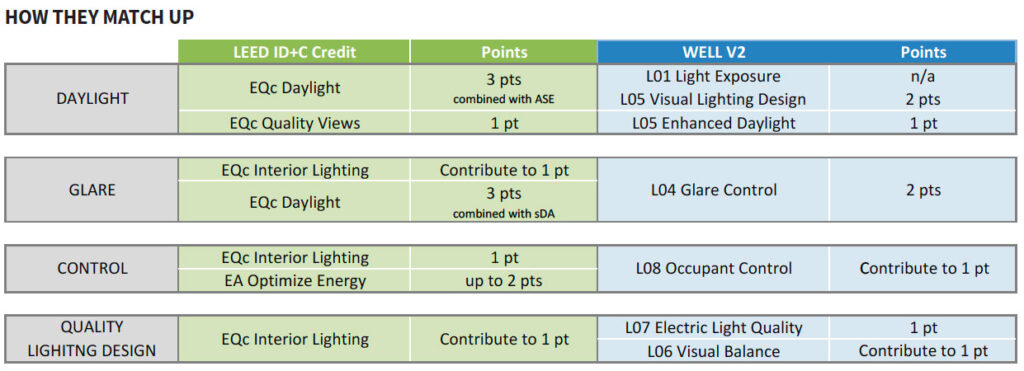What happens when two preeminent building standards come together? The authors explain
By Reiko Kagawa and Shahrzad Abtahi
 To create a truly sustainable building, designers need to focus not only on the building and its components but also on the building’s users and needs. LEED standards, assessed during the design and construction of buildings, focus on environmental impacts. The WELL Building Standard, however, is the next generation of design objectives and specifically addresses human health and well-being.
To create a truly sustainable building, designers need to focus not only on the building and its components but also on the building’s users and needs. LEED standards, assessed during the design and construction of buildings, focus on environmental impacts. The WELL Building Standard, however, is the next generation of design objectives and specifically addresses human health and well-being.
Although the two certifications are separate, lighting is a major element to achieve both LEED and WELL points. Understanding the overlaps as well as the contradictions will promote environmental responsibility and healthy building practices. The following four concepts have the most similarity and demonstrate how the two certifications can work together or, at times, conflict with each other’s goals:
DAYLIGHT
While LEED uses daylight as a natural resource to conserve energy, WELL uses it to stimulate circadian rhythm in the human body. The newly discovered ipRGC receptors in the human eye take cues from light to synchronize the body’s circadian rhythm to the 24-hour clock.
WELL solutions to maintain healthy circadian rhythm for the human body include:
- Daylight: Computer daylight modeling to simulate Spatial Daylight Autonomy (sDA) is required to prove that the majority of regular occupied spaces receive adequate daylight. The WELL daylight features are called L01: Light Exposure and Education and L05: Enhanced Daylight Access. The criteria for WELL aligns with the LEED V4 daylight requirements (maximum 3 points available for LEED when combined with Annual Sunlight Exposure [ASE] calculation).
- Electric Light (alternative approach to daylight): When sufficient daylight is not available, the higher light level provided by electric light can provide a similar effect as daylight on the human body. By going with this approach, the space requires a significantly higher light level than conventional lighting design. Hence, it uses more energy and contradicts LEED’s intent of energy conservation.
- Daylight Views: Access to daylight views is an important element for both LEED and WELL even though the use of daylight in the two certifications is different.
While circadian rhythm is such a large part of WELL, there is no equivalent in LEED that corresponds to WELL L03: Circadian Lighting Design, including use of tunable white light. This is the primary difference between the focus of LEED and WELL.
GLARE
LEED focuses on reducing the use of electrical lighting by introducing daylight into the space. WELL promotes enough daylight access for health. These concepts are successful when glare is controlled properly. Both solar glare and electric glare should be managed accordingly in order to provide a useful daylit space.
- Solar Glare: A computer daylight model to simulate Annual Sunlight Exposure (ASE) is required. This measures the amount of excess sunlight in a space. If too much sunlight is detected from the simulation, a shading device is required. ASE criteria on WELL L04: Glare Control aligns with LEED V4 daylight requirements. With this daylight analysis, up to 2 points are available for WELL and up to 3 points are available for LEED when combined with sDA requirements.
- Electric Glare: An excessively bright luminaire surface can cause glare. Both WELL and LEED require the light fixture to be under a certain brightness for visual comfort. WELL L04: Glare Control requires luminaire surfaces to be less than 10,000 cd/m2 and no shielding is required. This is less stringent than the LEED requirement of 2,500 cd/m2 for fixtures between 45 and 90 deg from nadir. While WELL provides up to 2 points for this feature, this is only 1 out of 8 criteria options (four required) to achieve LEED’s Interior Lighting credit, which offers only 1 point.
CONTROL
Control of lighting will provide custom lighting levels or settings to meet individual needs. WELL L08: Occupant Control of Lighting Environments requires very strict controllability. This extensive controllability overlaps with 2 points in LEED V4. Here are the requirements from the WELL L08 feature:
- Light systems are tunable and automated to meet the circadian and visual requirements of the occupants.
- Occupants have control of light levels, color temperature and color of electric light in their immediate environment and can override automated settings for at least 30% of operating hours.

An automated system to meet visual requirements will trigger both the daylight response as well as the occupancy sensors required by LEED under the Optimized Energy Performance credit. An occupant’s control of light levels under WELL will exceed requirements of the LEED Interior Lighting Control credit.
LIGHT QUALITY
Both WELL and LEED value the quality of light. The compatible requirements include:
- Color Rendering Quality: WELL L07: Electric Lighting Quality confirms the color rendering quality of electric light sources and flickerfree dimming. The intent of this credit on color rendering quality aligns for both WELL and LEED. WELL asks for CRI of 90 or CRI of 80 with R9 higher than 50; LEED asks for CRI above 80. There is no compatible point available for flicker-free systems in LEED.
- Visual Balance: WELL L06: Visual Balance recommends a required maximum contrast ratio in the space. Both WELL and LEED require a ceiling and wall contrast ratio to be less than 1:10. While 1 point is available for WELL under this feature, it is 1 of 8 criteria options (4 required) to achieve 1 point for LEED. In addition to the contrast ratio, WELL also requires consideration of eye adaptation. Any significant light level change has to be carried over the span of 30 minutes.
CONCLUSION
While LEED pushes for less energy use, WELL often requires more energy use to produce lighting that promotes emotional and physical wellness. Creating a balance that satisfies both LEED and WELL, or bridging the gap between the two, will in turn allow the project to be both environmentally responsible and cognizant of human health benefits.



